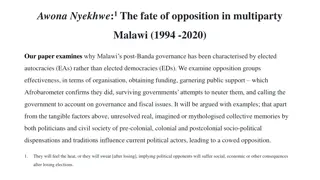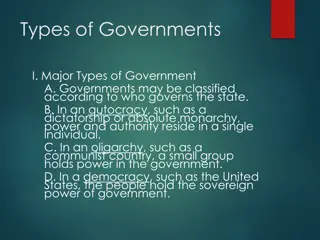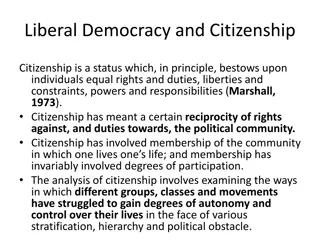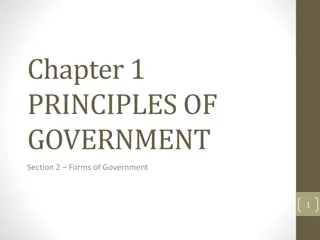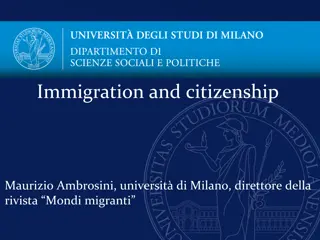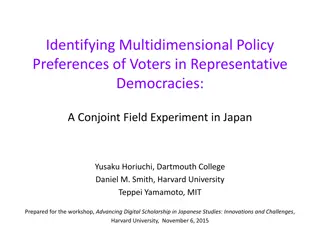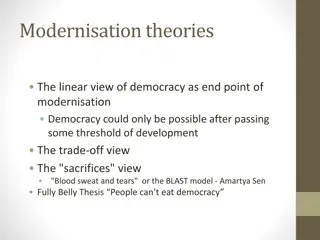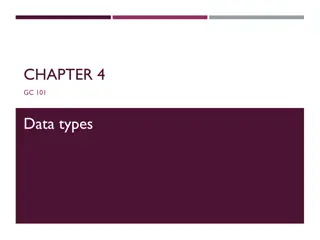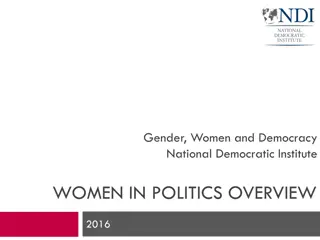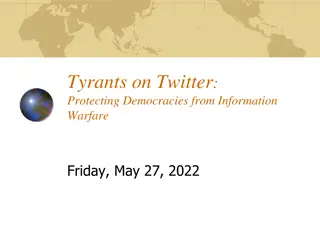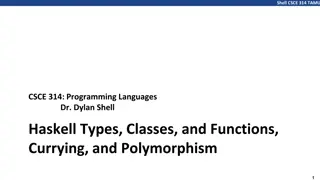Understanding Different Types of Democracies
Democracies can be classified into parliamentary, presidential, and semi-presidential systems based on their form of government. Each type has distinct characteristics, such as legislative responsibility and methods for government removal like votes of no confidence. Parliamentary and semi-presidential democracies give power to the elected legislature, while presidential democracies do not have legislative responsibility. Semi-presidential systems also feature a popularly elected head of state with a fixed term.
- Democracies
- Government Systems
- Legislative Responsibility
- Presidential Democracy
- Parliamentary Democracy
Uploaded on Oct 07, 2024 | 0 Views
Download Presentation

Please find below an Image/Link to download the presentation.
The content on the website is provided AS IS for your information and personal use only. It may not be sold, licensed, or shared on other websites without obtaining consent from the author. Download presentation by click this link. If you encounter any issues during the download, it is possible that the publisher has removed the file from their server.
E N D
Presentation Transcript
Parliamentary, Presidential and Semi-Presidential Democracies
Democracies are often classified according to the form of government that they have: Parliamentary Presidential Semi-Presidential
Classifying Parliamentary, Presidential, and Semi-Presidential Democracies DEMOCRACIES 1. Is the government responsible to the elected legislature? Yes: No: 2. Is the head of state popularly elected for a fixed term in office? PRESIDENTIAL DEMOCRACY No: Yes: PARLIAMENTARY SEMI-PRESIDENTIAL
Legislative responsibility refers to a situation in which a legislative majority has the constitutional power to remove a government from office without cause.
A vote of no confidence is initiated by the legislature the government must resign if it fails to obtain a legislative majority. A constructive vote of no confidence must indicate who will replace the government if the incumbent loses a vote of no confidence.
A vote of no confidence is initiated by the legislature the government must resign if it fails to obtain a legislative majority. A constructive vote of no confidence must indicate who will replace the government if the incumbent loses a vote of no confidence. A vote of confidence is initiated by the government the government must resign if it fails to obtain a legislative majority.
The defining feature of presidential democracies is that they dont have legislative responsibility. Parliamentary and semi-presidential democracies both have legislative responsibility.
In addition to legislative responsibility, semi-presidential democracies also have a head of state who s popularly elected for a fixed term.
A head of state is popularly elected if theyre elected through a process where voters either (1) cast a ballot directly for a candidate or (2) cast ballots to elect an electoral college, whose sole purpose is to elect the head of state. To serve a fixed term means the head of state serves for a fixed period of time before they need to be reappointed and can t be removedin the meantime.
In a democracy, the head of state is either a monarch or a president. Presidentscan exist in presidential, semi-presidential, and parliamentary democracies. Monarchsonly exist in parliamentary democracies they don t serve fixed terms and they re not directly elected.
Presidential: Democracies in which the government doesnt depend on a legislative majority to exist are presidential. Parliamentary: Democracies in which the government depends on a legislative majority to exist and in which the head of state isn t popularly elected for a fixed term are parliamentary. Semi-Presidential: Democracies in which the government depends on a legislative majority to exist and in which the head of state is popularly elected for a fixed term are semi-presidential.
Democracy Type, 2021 Parliamentary Presidential Semi-Presidential Albania, Andorra, Antigua and Barbuda, Australia, Bahamas, Barbados, Belgium, Belize, Bhutan, Canada, Denmark, Dominica, Estonia,Germany, Greece,Grenada,Guyana,Hungary, India,Israel,Italy,Jamaica, Japan, Kiribati,Kosovo,Latvia, Lesotho, Liechtenstein, Luxembourg, Malaysia, Malta,Marshall Islands,Mauritius, Moldova,Nauru, Nepal, Netherlands, New Zealand,Norway, Pakistan,Papua New Guinea,San Marino,Solomon Islands,Spain, St.Kitts andNevis,St. Lucia, St. Vincent and the Grenadines, Sweden, Trinidad and Tobago, Tuvalu, UnitedKingdom, Vanuatu Argentina,Benin,Bolivia, Brazil, Burundi, Chile, Colombia, Comoros, Costa Rica, Cyprus, Dominican Republic,Ecuador, El Salvador, Ghana, Guatemala, Honduras, Indonesia, Kenya, Liberia, Malawi, Maldives, Mexico, Micronesia, Nicaragua, Nigeria,Palau, Panama, Paraguay, Philippines, Seychelles, Sierra Leone, South Korea, Suriname, Switzerland, Turkey,United States,Uruguay, Zambia Armenia, Austria, Bulgaria, Cape Verde, Croatia,Czechia, East Timor, Finland, France, Georgia, Guinea-Bissau, Iceland,Ireland,Kyrgyzstan, Lithuania, Madagascar, Mongolia, Montenegro, North Macedonia, Peru, Poland, Portugal, Romania, S o Tom and Pr ncipe,Senegal, Serbia, Slovakia, Slovenia, Sri Lanka, Taiwan, Tunisia, Ukraine
The government in a parliamentary democracy comprises a prime minister and the cabinet. The prime minister is the political chief executive and head of the government. The cabinet is composed of ministers whose job it is to be in the cabinet and head the various government departments. In a parliamentary democracy, the executive branch and the government are the same thing.
Australian Government, 2022 Minister Department Minister Department Anthony Albanese Amanda Rishworth PrimeMinister SocialServices National Disability Insurance Scheme/ Government Services RichardMarles Defence BillShorten AttorneyGeneral/Cabinet Secretary PennyWong ForeignAffairs MarkDreyfus Brendan O Connor JimChalmers Treasurer Skillsand Training Finance/ Women/Public Service Katy Gallagher JasonClare Education TradeandTourism/Special Minister of State Housing/Homelessness/ Small Business Don Farrell JulieCollins EmploymentandWorkplace Relations/ the Arts Michelle Rowland TonyBurke Communications MarkButler HealthandAged Care MadeleineKing Resources/NorthernAustralia Agriculture, Fisheries andForestry/Emergency Management ChrisBowen ClimateChange and Energy MurrayWatt TanyaPlibersek Environment and Water Ed Husic IndustryandScience Infrastructure,Transport, RegionalDevelopmentand Local Government CatherineKing ClareO Neil HomeAffairs/ Cyber Security LindaBurney IndigenousAustralians
Ministerial responsibility refers to the constitutional doctrine by which cabinet ministers must bear ultimate responsibility for what happens in their ministry. Collective cabinet responsibility refers to the doctrine by which ministers must publicly support collective cabinet decisions or resign.
In a parliamentary democracy, voters do NOT elect governments. Instead, voters elect representatives, who then bargain over who should go into government.
In a parliamentary democracy, voters do NOT elect governments. Instead, voters elect representatives, who then bargain over who should go into government. So, how do governments form?
Estonian Legislative Elections, 2011 Party Seats Percentage Reform Party (RE) 33 32.7 Centre Party (KE) 26 25.7 Pro Patria and Res Publica Union(IRL) 23 22.8 Social DemocraticParty (SDE) 19 18.8 Total 101 100
The head of state presides over the government formation process and invests a government with the constitutional authority to take office. The extent to which the head of state is actively involved in the actual bargaining varies from country to country.
In some countries, the head of state is limited to simply swearing in the government proposed by party elites. These countries are characterized by free-style bargaining.
In some countries, the head of state chooses a particular politician a formateur to initiate the government formation process. A formateuris the person designated to form the government in a parliamentary democracy, and is often the PM designate. Very few countries explicitly state how the formateur is to be chosen.
In some countries, the head of state is restricted to appointing an informateur. An informateur examines politically feasible coalitions and nominates a formateur. These countries are often constitutional monarchies.
Despite the discretion of some heads of state, the first formateur is usually the leader of the largest legislative party. Once the formateur is chosen, they have to put a cabinet together that s acceptable to a legislative majority. Since it s rare in a parliamentary democracy for a single party to control a legislative majority, the formateur must begin bargaining with other parties.
Once a cabinet has been formed, the support of a legislative majority may or may not have to be demonstrated by a formal investiture vote.
An investiture vote is a formal vote in the legislature to determine whether a proposed government can take office. If the investiture vote fails, the government formation process starts again. If the investiture vote succeeds (or there s no investiture vote), the head of state appoints the cabinet to office.
The government is then free to rule until (1) its defeated in a vote of no confidence or (2) a new election is necessary.
A caretaker government occurs when an election is called or when an incumbent government either resigns or is defeated in a vote of no confidence. A caretaker government remains in office until the next government formation process is completed. In most countries, there s a strong norm that caretaker governments won t make important policy changes.
Estonian Legislative Elections, 2011 Party Seats Percentage Reform Party (RE) 33 32.7 Centre Party (KE) 26 25.7 Pro Patria and Res Publica Union(IRL) 23 22.8 Social DemocraticParty (SDE) 19 18.8 Total 101 100 What will the government be?
Potential Estonian Governments, 2011 Party Seats Percentage Surplusseats RE + KE +IRL+SDE 101 100 50 RE + KE +SDE 78 77.2 27 RE + KE +IRL 82 81.2 31 RE + IRL+ SDE 75 74.3 24 KE + IRL+SDE 68 67.3 17 RE + KE 59 58.4 8 RE + IRL 56 55.4 5 RE + SDE 52 51.5 1 KE + IRL 49 48.5 -2 KE + SDE 45 44.6 -6 IRL+ SDE 42 41.6 -9 RE 33 32.7 -18 KE 26 25.7 -25 IRL 23 22.8 -28 SDE 19 18.8 -32
The leader of the Reform Party (RE), Andrus Ansip, was appointed the formateur because he controlled the largest party. Let s eliminate all potential governments that don t include the RE and that don t control a legislative majority.
Potential Majority Estonian Governments including RE, 2011 Party Seats Percentage Surplus seats RE +KE +IRL+SDE 101 100 50 RE +KE +SDE 78 77.2 27 RE +KE +IRL 82 81.2 31 RE +IRL+SDE 75 74.3 24 RE +KE 59 58.4 8 RE +IRL 56 55.4 5 RE +SDE 52 51.5 1
What do politicians want? An office-seeking politician is interested in the intrinsic benefits of office. A policy-seeking politician wants to shape policy.
In an office-seeking world, a formateur can get other parties to join the government only by giving them office. Strong empirical evidence that a formateur has to give large parties more office than small parties.
Gamsons Law states that cabinet portfolios will be distributed among government parties in strict proportion to the number of seats each party contributes to the government s legislative seat total.
Example Party A (80 seats) and Party B (40 seats) form a government (120 seats). 80 120 2 3 Party A should receive = of the cabinet portfolios. 40 120 1 3 Party B should receive = of the cabinet portfolios.
Portfolio Allocation in 23 European Countries, 1945-2018 1 0.8 Perfect Proportionality Share of Cabinet Portfolios 0.6 0.4 0.2 0 0 0.2 Share of Government s Legislative Seats 0.4 0.6 0.8 1
An implication is that you wont want more parties in government than is strictly necessary to obtain a legislative majority. A minimal winning coalition (MWC) is one in which there are no parties that aren t required to control a legislative majority.
A second implication is that youll choose the smallest minimal winning coalition. A least minimal winning coalition is the MWC with the lowest number of surplus seats.
Three minimal winning coalitions: 1. RE + KE (8 surplus seats) 2. RE + IRL (5 surplus seats) 3. RE + SDE (1 surplus seat)
The least minimal winning coalition: 1. RE + KE (8 surplus seats) 2. RE + IRL (5 surplus seats) 3. RE + SDE (1 surplus seat)
In a policy-seeking world, a formateur can get other parties to join the government only by giving them policy concessions. It s likely that a formateur will have to give more policy concessions to large parties than small parties.
An implication is that youll want to form coalitions with parties that are located close to you in the policy space. A connected coalition is one in which the member parties are located directly next to each other in the policy space. A second implication is that you ll choose the connected least minimal winning coalition.
Estonian Party Positions, 2011 SDE KE RE IRL Left Right 19 26 33 23
The least connectedminimal winning coalition: 1. RE + KE (8 surplus seats) 2. RE + IRL (5 surplus seats) 3. RE + SDE (1 surplus seat)
A single-party majority government comprises a single party that controls a majority of the legislative seats. A minimal winning coalition (MWC) is one in which there are no parties that aren t required to control a legislative majority.
A single-party minority government comprises a single party that doesn t command a majority of the legislative seats. A minority coalition government comprises multiple governmental parties that don t together command a majority of the legislative seats. A surplus majority government comprises more parties than are strictly necessary to control a majority of the legislative seats.





